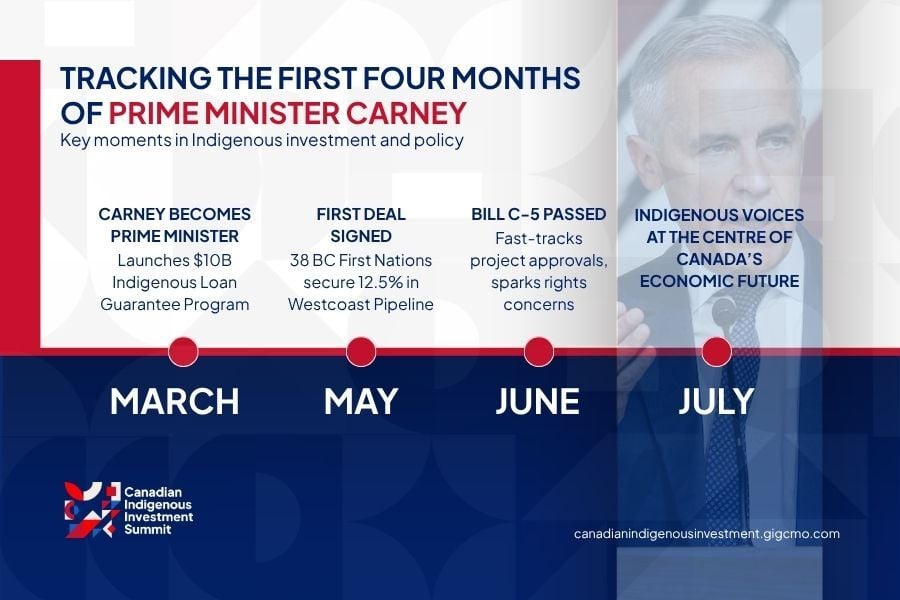Prime Minister Mark Carney's ambitious plan to unite Canada’s economy is currently facing fierce resistance from Indigenous leaders who argue his government is prioritizing speed over meaningful consultation with Indigenous peoples. Since taking office in March 2025, Carney has launched a $10 billion Indigenous Loan Guarantee Programme and fast-tracked major infrastructure projects, but his signature legislation has sparked legal challenges and walkouts from key Indigenous summits.

Carney became Canada's 24th Prime Minister on March 14, 2025, following Justin Trudeau's resignation in January amid mounting internal Liberal Party pressure and declining poll numbers. The former Bank of Canada and Bank of England governor won the Liberal leadership in a landslide victory, securing 85.9% of first-preference votes, and then led the party to a minority government victory in April's federal election.
Economic reconciliation through ownership stakes
One of Carney's approaches to the economy centres on what he terms "economic reconciliation" – moving beyond consultation toward Indigenous ownership of major infrastructure projects. His flagship initiative, the Indigenous Loan Guarantee Program, doubled from $5 billion to $10 billion in March 2025, providing loan guarantees between $20 million and $1 billion to help Indigenous communities acquire equity stakes in major projects.
The program's first major success came in May with a $400 million guarantee enabling 38 BC First Nations to acquire a 12.5% stake in Enbridge's Westcoast pipeline system. Carney has also committed $200 million to the Cedar LNG project, Kitimat, BC – an Indigenous majority-owned facility that will create 300 construction jobs and 100 permanent positions.
"What we heard from Prime Minister Carney was a commitment to fully and meaningfully advance First Nations priorities," said Assembly of First Nations National Chief Cindy Woodhouse Nepinak following Carney's election victory, expressing cautious optimism about his economic development approach.
Bill C-5 sparks widespread opposition
However, Carney's signature legislation, Bill C-5 (the Building Canada Act), has become a lightning rod for criticism. The law, which received Royal Assent on June 26, 2025, establishes a 2-year federal review timeline for nationally significant projects and allows the federal cabinet to bypass certain environmental assessments. Indigenous leaders argue the legislation fundamentally undermines their rights. "Bill C-5 centralizes power in Ottawa, lets cabinet override environmental laws, and ignores treaty and inherent rights. That is not modernization, it is colonization in 2025," said Chief Vernon Watchmaker of Kehewin Cree Nation.
The criticism intensified following a disastrous July 17 First Nations Summit in Ottawa, where Grand Chief Cody Diabo of Kahnawà:ke walked out early, calling the meeting "a complete disaster." Chiefs complained about last-minute agenda changes, limited access for support staff, and requirements to submit questions in advance through an online portal.
"Our rights cannot be implemented or respected without us, in substance and in process," Woodhouse Nepinak stated at the summit. "Until an appropriate process founded in free, prior and informed consent is established between First Nations rights holders and the Crown, the Crown's legal obligations will not be met."
The backlash has moved beyond rhetoric to the courts. In July, nine Ontario First Nations filed constitutional challenges against Bill C-5, arguing it grants "sweeping, unchecked powers to override protections for the environment, human rights, and Indigenous consultation processes."
Mixed reactions reflect complex dynamics
Not all Indigenous leaders oppose Carney's approach entirely. Inuit Tapiriit Kanatami President Natan Obed expressed cautious support: "I don't expect Prime Minister Mark Carney to get everything right immediately as he learns about and crafts policies for Indigenous Peoples, but it's clear he's willing to learn."
The Métis National Council has been more supportive, focusing on "strengthening Canada-U.S. relations, addressing tariffs, and advancing a unified Canadian economy through major projects" while keeping "Indigenous rights and environmental considerations at the forefront."
Some regional leaders acknowledge potential benefits despite process concerns. "Economic reconciliation is not just a buzzword," said Grand Chief Garrison Settee of Manitoba Keewatinowi Okimakanak, though he emphasized communities must "be part of the process."
Long-term implications for Indigenous economic participation
Despite the resistance, Carney's policies represent a fundamental shift in Canada towards Indigenous economic participation through ownership rather than consultation alone. The Indigenous Loan Guarantee Program's expansion to cover infrastructure, transportation, and trade sectors beyond energy could create unprecedented opportunities for Indigenous wealth generation.
However, the implementation challenges suggest this approach may face continued resistance. The program requires projects to "directly affect applicant's Section 35 rights" and maintain a minimum 25% investment from qualifying Indigenous groups, potentially limiting access for some communities.
The success of Carney's vision depends heavily on rebuilding trust with Indigenous leaders who cite decades of broken promises. With legal challenges pending and growing organized opposition, his minority government faces significant political constraints in advancing major infrastructure projects.
As Chief Phyllis Whitford of O'Chiese First Nation observed about the current consultation process: "This is a pre-determined process — a process that is disrespectful, top-down and divided Indigenous leaders." Whether Carney can address these fundamental concerns while maintaining his economic development timeline will determine if his Indigenous investment strategy becomes a model for reconciliation or another source of division.
